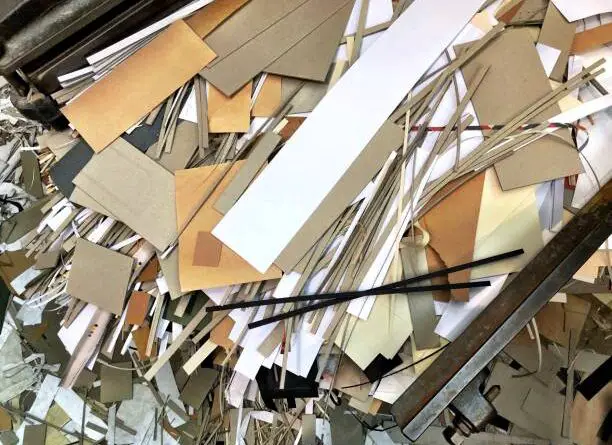The Products Derived From Composite Wastes
Materials that are made up of many components and are difficult to categorize as a single form of trash are referred to as composite wastes. Construction debris, which may include a blend of wood, metal, plastic, and other materials, and electronic waste (also known as e-waste), which may include a variety of various types of electronic devices and components, are two examples of composite wastes.
These wastes can be challenging to recycle or properly dispose of because each component might need a different kind of processing. These wastes may provide a number of risks, such as:
Combustible materials: are frequently found in composite wastes, which raises the danger of fire in facilities used for waste storage and disposal.
Health risks: People handling composite wastes or residing nearby waste disposal sites may be exposed to harmful substances such as pesticides and chemicals.
Environmental dangers: Hazardous substances like toxic chemicals and heavy metals can be found in composite wastes. These substances have the potential to contaminate the nearby ecosystem by seeping into the groundwater and soil.
Composite wastes: are frequently challenging to recycle because the various components must be separated before they can be processed. This process can be expensive and time-consuming.
Logistical problem: It is hazardous to transport and properly dispose of composite waste because of its mixed composition.
In general, composite wastes can be difficult to handle and dispose of safely. To reduce any potential risks, it is crucial to handle and dispose of these types of wastes correctly.
The management and disposal of mixed or composite waste streams, which are made up of different types of waste, are referred to as composite waste control. In order to ensure safe and environmentally responsible management, both hazardous and non-hazardous materials may need special handling and disposal techniques.
Segregation, treatment, and disposal methods, such as landfilling, incineration, and recycling, may all be used as composite waste control techniques.
The Products Derived From Composite Wastes

Although managing and disposing of these wastes might be challenging, they can also be recycled or processed to create new materials and goods. Products that may be made from composite wastes include, for instance:
(1) Recycled plastic
Plastic can be recycled from composite wastes to make new plastic goods like packaging, containers, and building supplies. As the world’s population continues to rise and more plastic products are consumed, recycling plastic waste has become an issue of increasing importance. Recycling composite plastic waste, which is a blend of various types of plastic, is one way to deal with this issue.
Packaging materials, consumer goods, and industrial waste are just a few of the sources of composite plastic waste. These materials are challenging to recycle because they contain various plastic types that are difficult to separate. New technologies, however, have been created to recycle waste composite plastic and turn it into fresh products.
The use of mechanical recycling, which pulverizes and shreds plastic waste using machines, is one illustration of this. Once sorted by type, these fragments can be processed into pellets that can be used to create new plastic goods. Compared to more conventional approaches to recycling plastic waste, this procedure is more effective and affordable.
Chemical recycling is a different strategy that involves dissolving plastic waste into its component chemicals so that they can be used to create new plastic products. Even plastic waste that is notoriously difficult to recycle, like laminated plastic and plastic-metal composites, may be recycled using this technique.
Recycling composite plastic waste has advantages for the economy in addition to helping to reduce the amount of plastic waste in the environment. Both manufacturers and consumers save money as a result of the decreased need for virgin materials and energy use.
Finally, recycling composite plastic waste is an essential step in lowering plastic pollution and enhancing sustainability. The ability to recycle this kind of waste and create new products is improving thanks to new technologies. We can advance in this area even further and contribute to the creation of a more sustainable future by continuing to invest in research and development.
Read Also: The Products Derived From Business Wastes
(2) Recycled paper
Paper-based composite wastes can be recycled to create new paper goods like cardboard, envelopes, and newspapers. An environmentally responsible and sustainable alternative to conventional paper production is recycled paper made from composite wastes.
Composite wastes are a combination of various materials, like plastic and paper, that are typically found in packaging and consumer goods. In addition to lowering the amount of waste dumped in landfills, recycling these wastes into paper also lessens the need for using virgin resources, like trees, to make paper.
There are several steps involved in turning composite wastes into recycled paper. The composite wastes are first gathered and sorted according to material type. The paper is then sent to a pulping facility after the plastic and paper have been separated.
The paper is disintegrated into fibers at the pulping facility, which are then cleaned and bleached to get rid of any impurities. After being thoroughly cleaned, the fibers are combined with water to create a slurry, which is then compressed and dried to produce recycled paper.
Compared to conventional paper production, recycled paper made from composite wastes has a number of advantages. Reducing the amount of waste that is dumped in landfills is one of the main advantages.
Additionally, it is more environmentally friendly to produce than conventional paper because it uses less water and energy. Furthermore, it lessens the need for virgin materials, like trees, to be used in the production of paper by using composite waste as the raw material.
As a result, recycling composite waste into paper is a viable and sustainable substitute for conventional paper production. It uses less energy and water during production, produces less waste that ends up in landfills, and lessens the demand for virgin materials. The conversion of composite waste into paper through recycling is a significant step toward building a more sustainable future.
(3) Used metals
Metals from composite wastes can be recycled to create new metal goods like cans, appliances, and automobiles. Recycling composite materials, such as those made of a combination of plastic and metal, has historically been difficult.
However, modern technological developments have made it possible to recover precious metals from composite waste, including e-waste and auto shredder residue (ASR).
Mechanical separation is one method for removing metals from composite waste. Using techniques like shredding, grinding, and air classification, the various materials present in the waste must be physically separated during this process.
Metals can then be separated from other materials by sorting the resulting material according to density and magnetic properties. Pyrometallurgical treatment is another technique for extracting metals from composite waste.
In order to extract the metal, this process involves heating the waste to high temperatures in the presence of a reducing agent, such as carbon. This technique allows for the separation of metals like copper and gold from the plastics and other materials present in the waste, making it particularly helpful for recovering metals from e-waste.
In addition to lowering the amount of waste dumped in landfills, recovering metals from composite waste also helps preserve natural resources. Numerous uses for the metals recovered from composite trash exist, including the development of new electronics and cars.
Finally, it has been difficult to recycle composite materials in the waste management industry, but new technological developments have made it feasible to extract precious metals from composite trash. Metals are often removed from composite waste by mechanical separation and pyrometallurgical processing.
Because these metals may be utilized in a number of applications, recovering them from composite trash not only helps to minimize the quantity of garbage that ends up in landfills, but it also helps to preserve natural resources.
Read Also: Chemical Wastes Complete Management Guide
(4) Fuel
Through procedures including pyrolysis, gasification, and combustion, composite wastes may also be utilized to create fuel. An inventive technique for turning diverse waste materials into a useful energy source is fuel from composite wastes.
In this process, waste materials like plastic, rubber, and wood are transformed into a fuel that may be utilized in engines, power plants, and other energy-intensive machinery. Fuel made from composite wastes has a number of advantages, one of which is that it lessens the quantity of garbage that is dumped in landfills.
These materials are transformed into a useful energy source rather than being discarded. This not only eases the burden on landfills but also lessens the amount of greenhouse gases that are released as a result of the decomposition of these materials.
Fuel made from composite wastes can also be produced more affordably than conventional fuels, which is a benefit. This is due to the fact that waste materials are frequently more affordable to purchase than the raw materials needed to produce conventional fuels like oil and gas.
Furthermore, the process of extracting and refining these materials into fuel is frequently simpler and less expensive than the process of producing fuel from traditional sources. Pyrolysis and gasification are two of the many ways composite wastes can be turned into fuel.
Pyrolysis is the process of heating waste materials without oxygen to convert them into liquid fuel. On the other hand, gasification entails heating the waste materials with oxygen present, creating a gas that may be utilized as fuel.
Despite the advantages of gasoline made from composite wastes, several obstacles still need to be removed before this form of fuel generation is more frequently used. The need to create more efficient and affordable technology for turning waste materials into fuel is one of the major issues.
Additionally, in order to increase support for this form of energy production, it is necessary to inform the general public and decision-makers about the advantages of fuel made from composite wastes.
In general, creating fuel from composite wastes is a promising way to turn trash into a useful energy source. This procedure can significantly contribute to reducing the environmental impact of our energy consumption by lowering the amount of waste that ends up in landfills and offering a reasonably priced substitute for conventional fuels.
(5) Compost
Compost, a nutrient-rich soil amendment that can be used in gardening and agriculture, is a product that can be made from the organic components of composite wastes. Organic waste, including food scraps and yard waste, are naturally transformed into compost, a nutrient-rich soil amendment.
Composite waste, which consists of a variety of materials, is one type of organic waste that can be composted. Food scraps, yard waste, paper products, and even some types of plastic can all be included in composite waste.
Composting is a great option for disposing of these materials because they are frequently unable to be recycled or composted quickly in a landfill. Prior to starting to compost composite waste, it is crucial to comprehend the various types of materials that may be used.
Food scraps are a great source of nitrogen for the compost pile, including eggshells, coffee grounds, and leftover fruit and vegetables. The carbon for the pile comes from yard waste, such as leaves, grass clippings, and twigs. Paper goods, including cardboard and newspaper, can also be added to the pile and will decompose over time.
Once the materials are well-balanced, it’s critical to maintain a damp but not swampy environment for the compost pile. To ensure that air reaches every area of the pile and to hasten the decomposition process, it should be turned frequently.
The temperature should be watched to make sure it stays within the ideal range for composting as the pile decomposes and heats up. Not all plastics can be composted, and it is best to avoid adding them to the pile because they are difficult to decompose and may harm the environment.
Composite waste can be composted to produce a nutrient-rich soil amendment that can be applied to gardens and landscaping. Compost is excellent for enhancing the structure of the soil, increasing water retention, and giving plants a boost of nutrients.
In conclusion, composting composite waste is a fantastic way to reuse organic materials and transform them into a useful soil amendment. Understanding the different kinds of waste that can be composted is crucial, as is maintaining the pile correctly to ensure proper decomposition. Your composite waste can be utilized as a beneficial resource for your garden with a little care.
(6) Biogas
By converting organic material into methane and carbon dioxide during anaerobic digestion, the organic components of composite wastes can be used to produce biogas.
Anaerobic digestion, a process that breaks down organic matter, produces biogas, a renewable energy source. Utilizing composite wastes, which are a blend of various organic waste types, is one method for producing biogas.
Food scraps, yard waste, and agricultural waste are examples of composite wastes. In a biogas plant, these materials are gathered and processed so that microorganisms can decompose them without oxygen. Methane produced by this process can be trapped and used as a fuel source.
There are many advantages to producing biogas from composite wastes. One benefit is that it lessens the amount of waste that is dumped in landfills. The need for fossil fuels can be decreased by using the generated biogas to produce electricity and heat.
Biogas can be made from composite wastes in a fairly straightforward manner. The waste is first collected and delivered to a biogas facility. They are then added to a digester that is anaerobically sealed with water and microorganisms.
Methane, carbon dioxide, and other gases are produced as a result of the microorganisms’ breakdown of the organic material. The carbon dioxide is frequently used for greenhouse farming while the methane is then captured and used as a fuel source.
The production of biogas from composite wastes is possible using a variety of biogas plants. The continuous-flow system is a popular choice that works well for large-scale operations.
The batch system is an additional choice that works better for smaller operations. The use of either type of system will depend on the particular requirements of the operation. Both have benefits and drawbacks.
In conclusion, the production of biogas from composite wastes is a sustainable and responsible method of generating energy. It produces a renewable energy source that can be used for electricity and heating while also assisting in the reduction of waste in landfills. Biogas from composite waste is a growingly popular option as the focus shifts to renewable energy and waste reduction.
Read Also: Rose Farming Guide



